| Listing 1 - 10 of 11 | << page >> |
Sort by
|
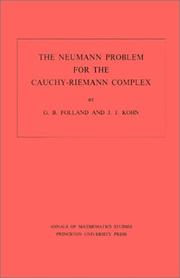
ISBN: 0691081204 1400881528 9780691081205 Year: 1972 Volume: 75 Publisher: Princeton, N.J. Princeton University Press
Abstract | Keywords | Export | Availability | Bookmark
 Loading...
Loading...Choose an application
- Reference Manager
- EndNote
- RefWorks (Direct export to RefWorks)
Part explanation of important recent work, and part introduction to some of the techniques of modern partial differential equations, this monograph is a self-contained exposition of the Neumann problem for the Cauchy-Riemann complex and certain of its applications. The authors prove the main existence and regularity theorems in detail, assuming only a knowledge of the basic theory of differentiable manifolds and operators on Hilbert space. They discuss applications to the theory of several complex variables, examine the associated complex on the boundary, and outline other techniques relevant to these problems. In an appendix they develop the functional analysis of differential operators in terms of Sobolev spaces, to the extent it is required for the monograph.
Functional analysis --- Neumann problem --- Differential operators --- Complex manifolds --- Complex manifolds. --- Differential operators. --- Neumann problem. --- Differential equations, Partial --- Équations aux dérivées partielles --- Analytic spaces --- Manifolds (Mathematics) --- Operators, Differential --- Differential equations --- Operator theory --- Boundary value problems --- A priori estimate. --- Almost complex manifold. --- Analytic function. --- Apply. --- Approximation. --- Bernhard Riemann. --- Boundary value problem. --- Calculation. --- Cauchy–Riemann equations. --- Cohomology. --- Compact space. --- Complex analysis. --- Complex manifold. --- Coordinate system. --- Corollary. --- Derivative. --- Differentiable manifold. --- Differential equation. --- Differential form. --- Differential operator. --- Dimension (vector space). --- Dirichlet boundary condition. --- Eigenvalues and eigenvectors. --- Elliptic operator. --- Equation. --- Estimation. --- Euclidean space. --- Existence theorem. --- Exterior (topology). --- Finite difference. --- Fourier analysis. --- Fourier transform. --- Frobenius theorem (differential topology). --- Functional analysis. --- Hilbert space. --- Hodge theory. --- Holomorphic function. --- Holomorphic vector bundle. --- Irreducible representation. --- Line segment. --- Linear programming. --- Local coordinates. --- Lp space. --- Manifold. --- Monograph. --- Multi-index notation. --- Nonlinear system. --- Operator (physics). --- Overdetermined system. --- Partial differential equation. --- Partition of unity. --- Potential theory. --- Power series. --- Pseudo-differential operator. --- Pseudoconvexity. --- Pseudogroup. --- Pullback. --- Regularity theorem. --- Remainder. --- Scientific notation. --- Several complex variables. --- Sheaf (mathematics). --- Smoothness. --- Sobolev space. --- Special case. --- Statistical significance. --- Sturm–Liouville theory. --- Submanifold. --- Tangent bundle. --- Theorem. --- Uniform norm. --- Vector field. --- Weight function. --- Operators in hilbert space --- Équations aux dérivées partielles
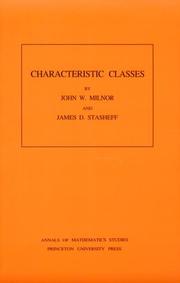
ISBN: 0691081220 9780691081229 140088182X Year: 1974 Volume: 76 Publisher: Princeton, N.J. Princeton University Press
Abstract | Keywords | Export | Availability | Bookmark
 Loading...
Loading...Choose an application
- Reference Manager
- EndNote
- RefWorks (Direct export to RefWorks)
The theory of characteristic classes provides a meeting ground for the various disciplines of differential topology, differential and algebraic geometry, cohomology, and fiber bundle theory. As such, it is a fundamental and an essential tool in the study of differentiable manifolds.In this volume, the authors provide a thorough introduction to characteristic classes, with detailed studies of Stiefel-Whitney classes, Chern classes, Pontrjagin classes, and the Euler class. Three appendices cover the basics of cohomology theory and the differential forms approach to characteristic classes, and provide an account of Bernoulli numbers.Based on lecture notes of John Milnor, which first appeared at Princeton University in 1957 and have been widely studied by graduate students of topology ever since, this published version has been completely revised and corrected.
Algebraic topology --- Characteristic classes --- Classes caractéristiques --- 515.16 --- #WWIS:d.d. Prof. L. Bouckaert/ALTO --- Classes, Characteristic --- Differential topology --- Topology of manifolds --- Characteristic classes. --- 515.16 Topology of manifolds --- Classes caractéristiques --- Additive group. --- Axiom. --- Basis (linear algebra). --- Boundary (topology). --- Bundle map. --- CW complex. --- Canonical map. --- Cap product. --- Cartesian product. --- Characteristic class. --- Charles Ehresmann. --- Chern class. --- Classifying space. --- Coefficient. --- Cohomology ring. --- Cohomology. --- Compact space. --- Complex dimension. --- Complex manifold. --- Complex vector bundle. --- Complexification. --- Computation. --- Conformal geometry. --- Continuous function. --- Coordinate space. --- Cross product. --- De Rham cohomology. --- Diffeomorphism. --- Differentiable manifold. --- Differential form. --- Differential operator. --- Dimension (vector space). --- Dimension. --- Direct sum. --- Directional derivative. --- Eilenberg–Steenrod axioms. --- Embedding. --- Equivalence class. --- Euler class. --- Euler number. --- Existence theorem. --- Existential quantification. --- Exterior (topology). --- Fiber bundle. --- Fundamental class. --- Fundamental group. --- General linear group. --- Grassmannian. --- Gysin sequence. --- Hausdorff space. --- Homeomorphism. --- Homology (mathematics). --- Homotopy. --- Identity element. --- Integer. --- Interior (topology). --- Isomorphism class. --- J-homomorphism. --- K-theory. --- Leibniz integral rule. --- Levi-Civita connection. --- Limit of a sequence. --- Linear map. --- Metric space. --- Natural number. --- Natural topology. --- Neighbourhood (mathematics). --- Normal bundle. --- Open set. --- Orthogonal complement. --- Orthogonal group. --- Orthonormal basis. --- Partition of unity. --- Permutation. --- Polynomial. --- Power series. --- Principal ideal domain. --- Projection (mathematics). --- Representation ring. --- Riemannian manifold. --- Sequence. --- Singular homology. --- Smoothness. --- Special case. --- Steenrod algebra. --- Stiefel–Whitney class. --- Subgroup. --- Subset. --- Symmetric function. --- Tangent bundle. --- Tensor product. --- Theorem. --- Thom space. --- Topological space. --- Topology. --- Unit disk. --- Unit vector. --- Variable (mathematics). --- Vector bundle. --- Vector space. --- Topologie differentielle --- Classes caracteristiques --- Classes et nombres caracteristiques
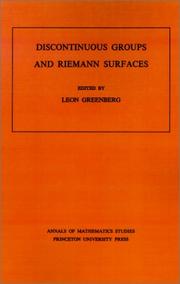
ISBN: 0691081387 1400881641 9780691081380 Year: 1974 Volume: 79 Publisher: Princeton, N.J.
Abstract | Keywords | Export | Availability | Bookmark
 Loading...
Loading...Choose an application
- Reference Manager
- EndNote
- RefWorks (Direct export to RefWorks)
Study 79 contains a collection of papers presented at the Conference on Discontinuous Groups and Ricmann Surfaces at the University of Maryland, May 21-25, 1973. The papers, by leading authorities, deal mainly with Fuchsian and Kleinian groups, Teichmüller spaces, Jacobian varieties, and quasiconformal mappings. These topics are intertwined, representing a common meeting of algebra, geometry, and analysis.
Group theory --- Complex analysis --- Number theory --- RIEMANN SURFACES --- Discontinuous groups --- congresses --- Congresses --- Riemann surfaces --- Congresses. --- Groupes discontinus --- Combinatorial topology --- Functions of complex variables --- Surfaces, Riemann --- Functions --- Abelian variety. --- Adjunction (field theory). --- Affine space. --- Algebraic curve. --- Algebraic structure. --- Analytic function. --- Arithmetic genus. --- Automorphism. --- Bernhard Riemann. --- Boundary (topology). --- Cauchy sequence. --- Cauchy–Schwarz inequality. --- Cayley–Hamilton theorem. --- Closed geodesic. --- Combination. --- Commutative diagram. --- Commutator subgroup. --- Compact Riemann surface. --- Complex dimension. --- Complex manifold. --- Complex multiplication. --- Complex space. --- Complex torus. --- Congruence subgroup. --- Conjugacy class. --- Convex set. --- Cyclic group. --- Degeneracy (mathematics). --- Diagram (category theory). --- Diffeomorphism. --- Differential form. --- Dimension (vector space). --- Disjoint sets. --- E7 (mathematics). --- Endomorphism. --- Equation. --- Equivalence class. --- Euclidean space. --- Existence theorem. --- Existential quantification. --- Finite group. --- Finitely generated group. --- Fuchsian group. --- Fundamental domain. --- Fundamental lemma (Langlands program). --- Fundamental polygon. --- Galois extension. --- Holomorphic function. --- Homeomorphism. --- Homology (mathematics). --- Homomorphism. --- Hurwitz's theorem (number theory). --- Inclusion map. --- Inequality (mathematics). --- Inner automorphism. --- Intersection (set theory). --- Irreducibility (mathematics). --- Isomorphism class. --- Isomorphism theorem. --- Jacobian variety. --- Jordan curve theorem. --- Kleinian group. --- Limit point. --- Mapping class group. --- Metric space. --- Monodromy. --- Monomorphism. --- Möbius transformation. --- Non-Euclidean geometry. --- Orthogonal trajectory. --- Permutation. --- Polynomial. --- Power series. --- Projective variety. --- Quadratic differential. --- Quadric. --- Quasi-projective variety. --- Quasiconformal mapping. --- Quotient space (topology). --- Rectangle. --- Riemann mapping theorem. --- Riemann surface. --- Schwarzian derivative. --- Simply connected space. --- Simultaneous equations. --- Special case. --- Subgroup. --- Subsequence. --- Surjective function. --- Symmetric space. --- Tangent space. --- Teichmüller space. --- Theorem. --- Topological space. --- Topology. --- Uniqueness theorem. --- Unit disk. --- Variable (mathematics). --- Winding number. --- Word problem (mathematics). --- RIEMANN SURFACES - congresses --- Discontinuous groups - Congresses --- Geometrie algebrique --- Fonctions d'une variable complexe --- Surfaces de riemann
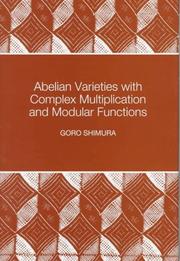
ISBN: 0691016569 1400883946 9780691016566 Year: 1998 Volume: 46 Publisher: Princeton, N.J. Princeton University Press
Abstract | Keywords | Export | Availability | Bookmark
 Loading...
Loading...Choose an application
- Reference Manager
- EndNote
- RefWorks (Direct export to RefWorks)
Reciprocity laws of various kinds play a central role in number theory. In the easiest case, one obtains a transparent formulation by means of roots of unity, which are special values of exponential functions. A similar theory can be developed for special values of elliptic or elliptic modular functions, and is called complex multiplication of such functions. In 1900 Hilbert proposed the generalization of these as the twelfth of his famous problems. In this book, Goro Shimura provides the most comprehensive generalizations of this type by stating several reciprocity laws in terms of abelian varieties, theta functions, and modular functions of several variables, including Siegel modular functions. This subject is closely connected with the zeta function of an abelian variety, which is also covered as a main theme in the book. The third topic explored by Shimura is the various algebraic relations among the periods of abelian integrals. The investigation of such algebraicity is relatively new, but has attracted the interest of increasingly many researchers. Many of the topics discussed in this book have not been covered before. In particular, this is the first book in which the topics of various algebraic relations among the periods of abelian integrals, as well as the special values of theta and Siegel modular functions, are treated extensively.
Ordered algebraic structures --- 512.74 --- Abelian varieties --- Modular functions --- Functions, Modular --- Elliptic functions --- Group theory --- Number theory --- Varieties, Abelian --- Geometry, Algebraic --- Algebraic groups. Abelian varieties --- 512.74 Algebraic groups. Abelian varieties --- Abelian varieties. --- Modular functions. --- Abelian extension. --- Abelian group. --- Abelian variety. --- Absolute value. --- Adele ring. --- Affine space. --- Affine variety. --- Algebraic closure. --- Algebraic equation. --- Algebraic extension. --- Algebraic number field. --- Algebraic structure. --- Algebraic variety. --- Analytic manifold. --- Automorphic function. --- Automorphism. --- Big O notation. --- CM-field. --- Characteristic polynomial. --- Class field theory. --- Coefficient. --- Complete variety. --- Complex conjugate. --- Complex multiplication. --- Complex number. --- Complex torus. --- Corollary. --- Degenerate bilinear form. --- Differential form. --- Direct product. --- Direct proof. --- Discrete valuation ring. --- Divisor. --- Eigenvalues and eigenvectors. --- Embedding. --- Endomorphism. --- Existential quantification. --- Field of fractions. --- Finite field. --- Fractional ideal. --- Function (mathematics). --- Fundamental theorem. --- Galois extension. --- Galois group. --- Galois theory. --- Generic point. --- Ground field. --- Group theory. --- Groupoid. --- Hecke character. --- Homology (mathematics). --- Homomorphism. --- Identity element. --- Integer. --- Irreducibility (mathematics). --- Irreducible representation. --- Lie group. --- Linear combination. --- Linear subspace. --- Local ring. --- Modular form. --- Natural number. --- Number theory. --- Polynomial. --- Prime factor. --- Prime ideal. --- Projective space. --- Projective variety. --- Rational function. --- Rational mapping. --- Rational number. --- Real number. --- Residue field. --- Riemann hypothesis. --- Root of unity. --- Scientific notation. --- Semisimple algebra. --- Simple algebra. --- Singular value. --- Special case. --- Subgroup. --- Subring. --- Subset. --- Summation. --- Theorem. --- Vector space. --- Zero element.
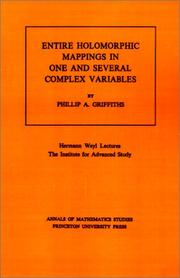
ISBN: 0691081719 0691081727 140088148X 9780691081724 9780691081717 Year: 1976 Volume: no. 85 Publisher: Princeton (N.J.) Princeton university press
Abstract | Keywords | Export | Availability | Bookmark
 Loading...
Loading...Choose an application
- Reference Manager
- EndNote
- RefWorks (Direct export to RefWorks)
The present monograph grew out of the fifth set of Hermann Weyl Lectures, given by Professor Griffiths at the Institute for Advanced Study, Princeton, in fall 1974.In Chapter 1 the author discusses Emile Borel's proof and the classical Jensen theorem, order of growth of entire analytic sets, order functions for entire holomorphic mappings, classical indicators of orders of growth, and entire functions and varieties of finite order.Chapter 2 is devoted to the appearance of curvature, and Chapter 3 considers the defect relations. The author considers the lemma on the logarithmic derivative, R. Nevanlinna's proof of the defect relation, and refinements of the classical case.
Complex analysis --- Holomorphic mappings --- Applications holomorphes --- 517.53 --- Mappings, Holomorphic --- Functions of several complex variables --- Mappings (Mathematics) --- Functions of a complex variable --- Holomorphic mappings. --- 517.53 Functions of a complex variable --- Fonctions de plusieurs variables complexes --- Fonctions entières --- Functions, Entire --- Algebraic variety. --- Analytic function. --- Analytic set. --- Armand Borel. --- Big O notation. --- Canonical bundle. --- Cartesian coordinate system. --- Characteristic function (probability theory). --- Characterization (mathematics). --- Chern class. --- Compact Riemann surface. --- Compact space. --- Complex analysis. --- Complex manifold. --- Complex projective space. --- Corollary. --- Counting. --- Curvature. --- Degeneracy (mathematics). --- Derivative. --- Differential form. --- Dimension. --- Divisor. --- Elementary proof. --- Entire function. --- Equation. --- Exponential growth. --- Gaussian curvature. --- Hermann Weyl. --- Hodge theory. --- Holomorphic function. --- Hyperplane. --- Hypersurface. --- Infinite product. --- Integral geometry. --- Invariant measure. --- Inverse problem. --- Jacobian matrix and determinant. --- Kähler manifold. --- Line bundle. --- Linear equation. --- Logarithmic derivative. --- Manifold. --- Meromorphic function. --- Modular form. --- Monograph. --- Nevanlinna theory. --- Nonlinear system. --- Phillip Griffiths. --- Picard theorem. --- Polynomial. --- Projective space. --- Q.E.D. --- Quantity. --- Ricci curvature. --- Riemann sphere. --- Scientific notation. --- Several complex variables. --- Special case. --- Stokes' theorem. --- Subset. --- Summation. --- Theorem. --- Theory. --- Uniformization theorem. --- Unit square. --- Volume form. --- Fonctions entières
Book
ISBN: 069108176X 1322884951 1400869307 0691636443 Year: 1978 Publisher: Princeton, N.J.
Abstract | Keywords | Export | Availability | Bookmark
 Loading...
Loading...Choose an application
- Reference Manager
- EndNote
- RefWorks (Direct export to RefWorks)
The classical uniformization theorem for Riemann surfaces and its recent extensions can be viewed as introducing special pseudogroup structures, affine or projective structures, on Riemann surfaces. In fact, the additional structures involved can be considered as local forms of the uniformizations of Riemann surfaces. In this study, Robert Gunning discusses the corresponding pseudogroup structures on higher-dimensional complex manifolds, modeled on the theory as developed for Riemann surfaces.Originally published in 1978.The Princeton Legacy Library uses the latest print-on-demand technology to again make available previously out-of-print books from the distinguished backlist of Princeton University Press. These editions preserve the original texts of these important books while presenting them in durable paperback and hardcover editions. The goal of the Princeton Legacy Library is to vastly increase access to the rich scholarly heritage found in the thousands of books published by Princeton University Press since its founding in 1905.
Analytical spaces --- Differential geometry. Global analysis --- Complex manifolds --- Connections (Mathematics) --- Pseudogroups --- Mathematics --- Physical Sciences & Mathematics --- Calculus --- Global analysis (Mathematics) --- Lie groups --- Geometry, Differential --- Analytic spaces --- Manifolds (Mathematics) --- Adjunction formula. --- Affine connection. --- Affine transformation. --- Algebraic surface. --- Algebraic torus. --- Algebraic variety. --- Analytic continuation. --- Analytic function. --- Automorphic function. --- Automorphism. --- Bilinear form. --- Canonical bundle. --- Characterization (mathematics). --- Cohomology. --- Compact Riemann surface. --- Complex Lie group. --- Complex analysis. --- Complex dimension. --- Complex manifold. --- Complex multiplication. --- Complex number. --- Complex plane. --- Complex torus. --- Complex vector bundle. --- Contraction mapping. --- Covariant derivative. --- Differentiable function. --- Differentiable manifold. --- Differential equation. --- Differential form. --- Differential geometry. --- Differential operator. --- Dimension (vector space). --- Dimension. --- Elliptic operator. --- Elliptic surface. --- Enriques surface. --- Equation. --- Existential quantification. --- Explicit formula. --- Explicit formulae (L-function). --- Exterior derivative. --- Fiber bundle. --- General linear group. --- Geometric genus. --- Group homomorphism. --- Hausdorff space. --- Holomorphic function. --- Homomorphism. --- Identity matrix. --- Invariant subspace. --- Invertible matrix. --- Irreducible representation. --- Jacobian matrix and determinant. --- K3 surface. --- Kähler manifold. --- Lie algebra representation. --- Lie algebra. --- Line bundle. --- Linear equation. --- Linear map. --- Linear space (geometry). --- Linear subspace. --- Manifold. --- Mathematical analysis. --- Mathematical induction. --- Ordinary differential equation. --- Partial differential equation. --- Permutation. --- Polynomial. --- Principal bundle. --- Projection (linear algebra). --- Projective connection. --- Projective line. --- Pseudogroup. --- Quadratic transformation. --- Quotient space (topology). --- Representation theory. --- Riemann surface. --- Riemann–Roch theorem. --- Schwarzian derivative. --- Sheaf (mathematics). --- Special case. --- Subalgebra. --- Subgroup. --- Submanifold. --- Symmetric tensor. --- Symmetrization. --- Tangent bundle. --- Tangent space. --- Tensor field. --- Tensor product. --- Tensor. --- Theorem. --- Topological manifold. --- Uniformization theorem. --- Uniformization. --- Unit (ring theory). --- Vector bundle. --- Vector space. --- Fonctions de plusieurs variables complexes --- Variétés complexes
Book
ISBN: 0691643024 1400853656 9781400853656 9781306988988 1306988985 0691082510 9780691615622 Year: 1981 Publisher: Princeton (N.J.): Princeton university press
Abstract | Keywords | Export | Availability | Bookmark
 Loading...
Loading...Choose an application
- Reference Manager
- EndNote
- RefWorks (Direct export to RefWorks)
The purpose of this book is to provide a self-contained account, accessible to the non-specialist, of algebra necessary for the solution of the integrability problem for transitive pseudogroup structures.Originally published in 1981.The Princeton Legacy Library uses the latest print-on-demand technology to again make available previously out-of-print books from the distinguished backlist of Princeton University Press. These editions preserve the original texts of these important books while presenting them in durable paperback and hardcover editions. The goal of the Princeton Legacy Library is to vastly increase access to the rich scholarly heritage found in the thousands of books published by Princeton University Press since its founding in 1905.
Lie algebras. --- Ideals (Algebra) --- Pseudogroups. --- Global analysis (Mathematics) --- Lie groups --- Algebraic ideals --- Algebraic fields --- Rings (Algebra) --- Algebras, Lie --- Algebra, Abstract --- Algebras, Linear --- Lie algebras --- Pseudogroups --- 512.81 --- 512.81 Lie groups --- Ideals (Algebra). --- Lie, Algèbres de. --- Idéaux (algèbre) --- Pseudogroupes (mathématiques) --- Ordered algebraic structures --- Analytical spaces --- Addition. --- Adjoint representation. --- Algebra homomorphism. --- Algebra over a field. --- Algebraic extension. --- Algebraic structure. --- Analytic function. --- Associative algebra. --- Automorphism. --- Bilinear form. --- Bilinear map. --- Cartesian product. --- Closed graph theorem. --- Codimension. --- Coefficient. --- Cohomology. --- Commutative ring. --- Commutator. --- Compact space. --- Complex conjugate. --- Complexification (Lie group). --- Complexification. --- Conjecture. --- Constant term. --- Continuous function. --- Contradiction. --- Corollary. --- Counterexample. --- Diagram (category theory). --- Differentiable manifold. --- Differential form. --- Differential operator. --- Dimension (vector space). --- Dimension. --- Direct sum. --- Discrete space. --- Donald C. Spencer. --- Dual basis. --- Embedding. --- Epimorphism. --- Existential quantification. --- Exterior (topology). --- Exterior algebra. --- Exterior derivative. --- Faithful representation. --- Formal power series. --- Graded Lie algebra. --- Ground field. --- Homeomorphism. --- Homomorphism. --- Hyperplane. --- I0. --- Indeterminate (variable). --- Infinitesimal transformation. --- Injective function. --- Integer. --- Integral domain. --- Invariant subspace. --- Invariant theory. --- Isotropy. --- Jacobi identity. --- Levi decomposition. --- Lie algebra. --- Linear algebra. --- Linear map. --- Linear subspace. --- Local diffeomorphism. --- Mathematical induction. --- Maximal ideal. --- Module (mathematics). --- Monomorphism. --- Morphism. --- Natural transformation. --- Non-abelian. --- Partial differential equation. --- Pseudogroup. --- Pullback (category theory). --- Simple Lie group. --- Space form. --- Special case. --- Subalgebra. --- Submanifold. --- Subring. --- Summation. --- Symmetric algebra. --- Symplectic vector space. --- Telescoping series. --- Theorem. --- Topological algebra. --- Topological space. --- Topological vector space. --- Topology. --- Transitive relation. --- Triviality (mathematics). --- Unit vector. --- Universal enveloping algebra. --- Vector bundle. --- Vector field. --- Vector space. --- Weak topology. --- Lie, Algèbres de. --- Idéaux (algèbre) --- Pseudogroupes (mathématiques)
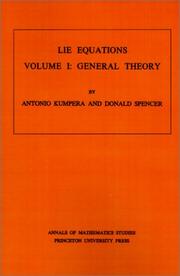
ISBN: 0691081115 9780691081113 1400881730 Year: 1972 Volume: 73 Publisher: Princeton (N.J.) Princeton university press
Abstract | Keywords | Export | Availability | Bookmark
 Loading...
Loading...Choose an application
- Reference Manager
- EndNote
- RefWorks (Direct export to RefWorks)
In this monograph the authors redevelop the theory systematically using two different approaches. A general mechanism for the deformation of structures on manifolds was developed by Donald Spencer ten years ago. A new version of that theory, based on the differential calculus in the analytic spaces of Grothendieck, was recently given by B. Malgrange. The first approach adopts Malgrange's idea in defining jet sheaves and linear operators, although the brackets and the non-linear theory arc treated in an essentially different manner. The second approach is based on the theory of derivations, and its relationship to the first is clearly explained. The introduction describes examples of Lie equations and known integrability theorems, and gives applications of the theory to be developed in the following chapters and in the subsequent volume.
Differential geometry. Global analysis --- Lie groups --- Lie algebras --- Differential equations --- Groupes de Lie --- Algèbres de Lie --- Equations différentielles --- 514.76 --- Groups, Lie --- Symmetric spaces --- Topological groups --- Algebras, Lie --- Algebra, Abstract --- Algebras, Linear --- Equations, Differential --- Bessel functions --- Calculus --- Geometry of differentiable manifolds and of their submanifolds --- Differential equations. --- Lie algebras. --- Lie groups. --- 517.91 Differential equations --- 514.76 Geometry of differentiable manifolds and of their submanifolds --- Algèbres de Lie --- Equations différentielles --- 517.91. --- Numerical solutions --- Surfaces, Deformation of --- Surfaces (mathématiques) --- Déformation --- Pseudogroups. --- Pseudogroupes (mathématiques) --- 517.91 --- Adjoint representation. --- Adjoint. --- Affine transformation. --- Alexander Grothendieck. --- Analytic function. --- Associative algebra. --- Atlas (topology). --- Automorphism. --- Bernhard Riemann. --- Big O notation. --- Bundle map. --- Category of topological spaces. --- Cauchy–Riemann equations. --- Coefficient. --- Commutative diagram. --- Commutator. --- Complex conjugate. --- Complex group. --- Complex manifold. --- Computation. --- Conformal map. --- Continuous function. --- Coordinate system. --- Corollary. --- Cotangent bundle. --- Curvature tensor. --- Deformation theory. --- Derivative. --- Diagonal. --- Diffeomorphism. --- Differentiable function. --- Differential form. --- Differential operator. --- Differential structure. --- Direct proof. --- Direct sum. --- Ellipse. --- Endomorphism. --- Equation. --- Exact sequence. --- Exactness. --- Existential quantification. --- Exponential function. --- Exponential map (Riemannian geometry). --- Exterior derivative. --- Fiber bundle. --- Fibration. --- Frame bundle. --- Frobenius theorem (differential topology). --- Frobenius theorem (real division algebras). --- Group isomorphism. --- Groupoid. --- Holomorphic function. --- Homeomorphism. --- Integer. --- J-invariant. --- Jacobian matrix and determinant. --- Jet bundle. --- Linear combination. --- Linear map. --- Manifold. --- Maximal ideal. --- Model category. --- Morphism. --- Nonlinear system. --- Open set. --- Parameter. --- Partial derivative. --- Partial differential equation. --- Pointwise. --- Presheaf (category theory). --- Pseudo-differential operator. --- Pseudogroup. --- Quantity. --- Regular map (graph theory). --- Requirement. --- Riemann surface. --- Right inverse. --- Scalar multiplication. --- Sheaf (mathematics). --- Special case. --- Structure tensor. --- Subalgebra. --- Subcategory. --- Subgroup. --- Submanifold. --- Subset. --- Tangent bundle. --- Tangent space. --- Tangent vector. --- Tensor field. --- Tensor product. --- Theorem. --- Torsion tensor. --- Transpose. --- Variable (mathematics). --- Vector bundle. --- Vector field. --- Vector space. --- Volume element. --- Surfaces (mathématiques) --- Déformation --- Analyse sur une variété
Book
ISBN: 0691080763 132288496X 0691620687 0691647429 1400869315 Year: 1970 Publisher: Princeton (N.J.): Princeton university press
Abstract | Keywords | Export | Availability | Bookmark
 Loading...
Loading...Choose an application
- Reference Manager
- EndNote
- RefWorks (Direct export to RefWorks)
The present volume reflects both the diversity of Bochner's pursuits in pure mathematics and the influence his example and thought have had upon contemporary researchers.Originally published in 1971.The Princeton Legacy Library uses the latest print-on-demand technology to again make available previously out-of-print books from the distinguished backlist of Princeton University Press. These editions preserve the original texts of these important books while presenting them in durable paperback and hardcover editions. The goal of the Princeton Legacy Library is to vastly increase access to the rich scholarly heritage found in the thousands of books published by Princeton University Press since its founding in 1905.
Mathematical analysis --- -Advanced calculus --- Analysis (Mathematics) --- Algebra --- Addresses, essays, lectures --- Mathematical analysis. --- -517.1 Mathematical analysis --- -Addresses, essays, lectures --- 517.1 Mathematical analysis --- 517.1. --- Approximation theory. --- System analysis. --- 517.1 --- Network analysis --- Network science --- Network theory --- Systems analysis --- System theory --- Mathematical optimization --- Theory of approximation --- Functional analysis --- Functions --- Polynomials --- Chebyshev systems --- Absolute continuity. --- Analytic continuation. --- Analytic function. --- Asymptotic expansion. --- Automorphism. --- Banach algebra. --- Banach space. --- Bessel function. --- Big O notation. --- Bounded operator. --- Branch point. --- Cauchy's integral formula. --- Cauchy's integral theorem. --- Characterization (mathematics). --- Cohomology. --- Commutative property. --- Compact operator. --- Compact space. --- Complex analysis. --- Complex number. --- Complex plane. --- Continuous function (set theory). --- Continuous function. --- Convolution. --- Coset. --- Covariance operator. --- Differentiable function. --- Differentiable manifold. --- Differential form. --- Dimension (vector space). --- Discrete group. --- Dominated convergence theorem. --- Eigenfunction. --- Eigenvalues and eigenvectors. --- Equation. --- Equivalence class. --- Even and odd functions. --- Existential quantification. --- First variation. --- Formal power series. --- Fréchet derivative. --- Fubini's theorem. --- Function space. --- Functional analysis. --- Fundamental group. --- Green's function. --- Haar measure. --- Hermite polynomials. --- Hermitian symmetric space. --- Holomorphic function. --- Hyperbolic partial differential equation. --- Infimum and supremum. --- Infinite product. --- Integral equation. --- Lebesgue measure. --- Lie algebra. --- Lie group. --- Linear map. --- Markov chain. --- Meromorphic function. --- Metric space. --- Monotonic function. --- Natural number. --- Norm (mathematics). --- Normal subgroup. --- Null set. --- Partition of unity. --- Pointwise. --- Polynomial. --- Power series. --- Pseudogroup. --- Riemann surface. --- Riemannian manifold. --- Schrödinger equation. --- Self-adjoint operator. --- Self-adjoint. --- Semigroup. --- Semisimple algebra. --- Sesquilinear form. --- Sign (mathematics). --- Singular perturbation. --- Special case. --- Spectral theory. --- Stokes' theorem. --- Subgroup. --- Submanifold. --- Subset. --- Support (mathematics). --- Symplectic geometry. --- Symplectic manifold. --- Theorem. --- Uniform convergence. --- Unitary operator. --- Unitary representation. --- Upper and lower bounds. --- Vector bundle. --- Vector field. --- Volterra's function. --- Weierstrass theorem. --- Zorn's lemma.
Book
ISBN: 0691080771 1322886709 0691621365 1400871239 0691648026 9780691080772 Year: 1976 Publisher: Princeton (N.J.): Princeton university press
Abstract | Keywords | Export | Availability | Bookmark
 Loading...
Loading...Choose an application
- Reference Manager
- EndNote
- RefWorks (Direct export to RefWorks)
Global analysis describes diverse yet interrelated research areas in analysis and algebraic geometry, particularly those in which Kunihiko Kodaira made his most outstanding contributions to mathematics. The eminent contributors to this volume, from Japan, the United States, and Europe, have prepared original research papers that illustrate the progress and direction of current research in complex variables and algebraic and differential geometry. The authors investigate, among other topics, complex manifolds, vector bundles, curved 4-dimensional space, and holomorphic mappings. Bibliographies facilitate further reading in the development of the various studies.Originally published in 1970.The Princeton Legacy Library uses the latest print-on-demand technology to again make available previously out-of-print books from the distinguished backlist of Princeton University Press. These editions preserve the original texts of these important books while presenting them in durable paperback and hardcover editions. The goal of the Princeton Legacy Library is to vastly increase access to the rich scholarly heritage found in the thousands of books published by Princeton University Press since its founding in 1905.
Differential geometry. Global analysis --- Global analysis (Mathematics) --- Calculus of variations --- Differentiable manifolds --- 517.97 --- Analysis, Global (Mathematics) --- Differential topology --- Functions of complex variables --- Geometry, Algebraic --- Calculus of variations. Mathematical theory of control --- Differentiable manifolds. --- Calculus of variations. --- Global analysis (Mathematics). --- 517.97 Calculus of variations. Mathematical theory of control --- Algebraic topology --- 514.7 --- -Calculus of variations --- #TCPW W3.0 --- #TCPW W3.2 --- #WWIS:MEET --- Differential manifolds --- Manifolds (Mathematics) --- Isoperimetrical problems --- Variations, Calculus of --- Maxima and minima --- Differential geometry. Algebraic and analytic methods in geometry --- 514.7 Differential geometry. Algebraic and analytic methods in geometry --- Addresses, essays, lectures --- Functional analysis --- Geometry --- Algebra homomorphism. --- Algebraic space. --- Associated graded ring. --- Automorphism. --- Betti number. --- Bilinear form. --- Canonical basis. --- Canonical bundle. --- Closed immersion. --- Codimension. --- Coefficient. --- Cohomology. --- Cokernel. --- Complete intersection. --- Complex manifold. --- Complex torus. --- Convex cone. --- Covering space. --- Dedekind domain. --- Deformation theory. --- Degenerate bilinear form. --- Diagram (category theory). --- Diffeomorphism. --- Differential form. --- Discrete group. --- Discrete valuation ring. --- Divisor. --- Elliptic operator. --- Elliptic surface. --- Endomorphism. --- Enriques surface. --- Epimorphism. --- Equation. --- Exact sequence. --- Existential quantification. --- Extremal length. --- Fiber bundle. --- Flat morphism. --- Frame bundle. --- Functor. --- Generic point. --- Grassmannian. --- Harmonic function. --- Heine–Borel theorem. --- Hensel's lemma. --- Holomorphic function. --- Homogeneous coordinates. --- Homomorphism. --- Hyperplane. --- Invertible sheaf. --- Kodaira embedding theorem. --- Kodaira vanishing theorem. --- Lie algebra. --- Line bundle. --- Linear independence. --- Linear map. --- Local ring. --- Mathematical induction. --- Meromorphic function. --- Metric space. --- Morphism. --- Natural number. --- Norm (mathematics). --- Normal extension. --- Normal subgroup. --- Open set. --- Orientability. --- Orthonormal basis. --- Partition of unity. --- Polynomial. --- Principal bundle. --- Principal homogeneous space. --- Projection (mathematics). --- Projective line. --- Quadric. --- Rational singularity. --- Residue field. --- Riemannian manifold. --- Ring homomorphism. --- Self-adjoint operator. --- Sheaf (mathematics). --- Sobolev space. --- Special case. --- Stokes' theorem. --- Subgroup. --- Submanifold. --- Subset. --- Subspace theorem. --- Summation. --- Surjective function. --- Symmetric tensor. --- Symplectic vector space. --- Tangent space. --- Theorem. --- Universal bundle. --- Upper and lower bounds. --- Vector bundle. --- Vector field. --- Wirtinger inequality (2-forms). --- Zariski topology. --- Analyse globale (mathématiques) --- Calcul des variations --- Analyse globale (mathématiques) --- Kodaira (kunihiko), mathematicien japonais, 1915 --- -Kodaira (kunihiko), mathematicien japonais, 1915 --- -517.97 --- -Analyse globale (mathématiques) --- -Algebraic topology
| Listing 1 - 10 of 11 | << page >> |
Sort by
|

 Search
Search Feedback
Feedback About UniCat
About UniCat  Help
Help News
News